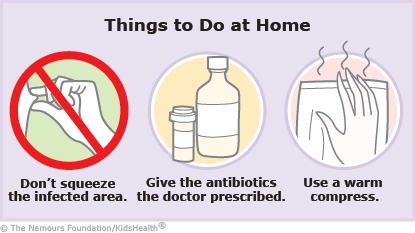Breast Infection (Mastitis): How to Care for Your Child
Antibiotics usually clear up a breast infection and help a child feel better.


A breast infection (also called mastitis) most often happens in young infants or in breastfeeding women. However, children and adolescents also can get mastitis. In this age group, it is more common in girls.
A breast infection typically starts when bacteria enter a cut or scratch in the skin of the breast. Shaving or piercing the nipple area, obesity, or a skin infection near the nipple can make a breast infection more likely. Symptoms often include an area of pain, swelling, puffiness, warmth, and redness. Sometimes there is discharge from the nipple. The infection usually occurs only on one side. A child with a breast infection may feel ill, develop swollen glands (lymph nodes) under the arms, or have fever or chills.
The health care provider talked to you and your child and did an examination to diagnose mastitis. Often no other tests are necessary. Antibiotics are needed to treat the infection and to prevent a breast abscess (a pus-filled area) from forming.

-
The entire course of antibiotics should be completed as directed, even if your child feels better in a few days.
-
If your child has a fever and is uncomfortable, a medication may help:
-
For children under 6 months, you may give acetaminophen.
-
For children over 6 months, you may give acetaminophen OR ibuprofen, if recommended by your health care provider.
-
Avoid touching or squeezing the infected area.
-
Make a warm compress by wetting a washcloth with warm (not hot) water. Apply it for 15–20 minutes four times a day.
-
Check the infected area daily for increasing redness or swelling.
-
Make a follow-up appointment with your health care provider as directed to make sure the infection is getting better.

Your child:
-
Does not improve after following the health care provider's instructions.
-
Has new or increased liquid draining from the breast.
-
Has increased swelling of the breast.
-
Develops a new or higher fever.
-
Has increased redness, swelling, or pain.
-
Is not able to take the medication.

Your child:
-
Develops red streaks spreading from the infected area.
-
Seems to be getting worse or seems very ill.
-
Appears dehydrated; signs include dizziness, drowsiness, a dry or sticky mouth, sunken eyes, producing less urine or darker than usual urine, crying with little or no tears.